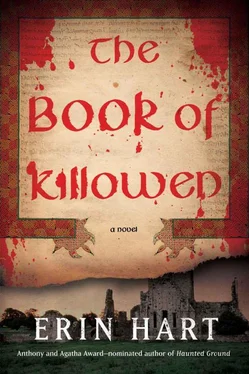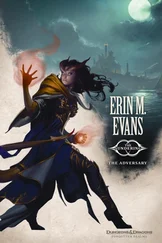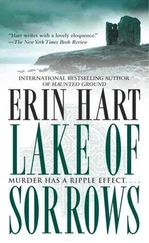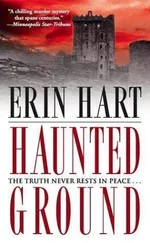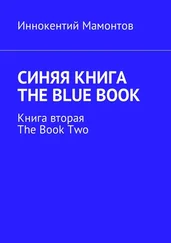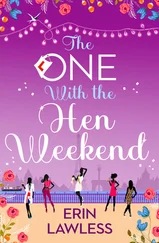“Interesting proposition,” Stella said. “I’m not sure how I can help—”
Claire Finnerty’s voice was low but urgent. “You must know people. It’s too late for Anca, but we want to do something—we have to do something—to make amends.”
Stella looked into the eyes of the woman before her and saw the whole picture: the resolute expression, the sweat-stained clothing and worn hands, dirt under the nails, unruly hair only partially constrained by a head scarf. Here was a simple portrait of human need, a need that, for once, was within her power to answer.
“All right,” Stella said. “Let me make some inquiries. I’ll see what I can do.”
“Thank you.” Claire Finnerty’s expression was still intense, but something in her eyes seemed to brighten. As she bent to collect her packages, Stella glimpsed a small strip of ink inscribed on her lower back—a delicate scalloped pattern in blues and greens. The shirt rode up slightly as she slung one of the bags over her shoulder, briefly exposing the whole tattoo. Stella could see that it was a snake swallowing its own tail. At the door, Claire Finnerty turned back to her. “Anytime after eight tonight. Just a simple home wake.”
Stella returned to her office, feeling that she hadn’t probed deeply enough. Why had the person who called herself Claire Finnerty taken the identity of a dead child? What was she running from? It might be wise to find out more about the circumstances of Tricia Woulfe’s disappearance before trying to throw the light on someone with an assumed identity. A person could have all sorts of reasons for not wanting to be found. Interesting that Claire Finnerty was so eager to make amends for Anca Popescu’s death. Perhaps the clue was embedded in that need.
Her desk was covered with open files and half-finished reports, not to mention all the piles she’d begun to try and organize Molloy’s stuff. Time to force a bit of order and logic on the clutter of thoughts and images that filled her mind, as well as the mess of papers on the desk.
Her gaze caught on a photo of the Cregganroe conspirators, and this time her eye was drawn not to the shaggy young men but to a pair of peripheral figures, a young woman locked in an embrace with a tall man at the edge of the frame. Neither of their faces was visible, obscured by moppish haircuts of the time. They seemed disconnected from the others, Stella thought, with the fella’s hand right up under the back of his girl’s jumper. And then she saw it: the scalloped pattern on the girl’s right hip. Stella flipped the photo over, looking for the note about the identities of the subjects, but the label mentioned only the five young men at the table, nothing about the other two. She reached for the magnifying glass, trying to get a read on the tattoo. If she could enhance the image, there’d be a much better chance… and all at once, the marks took shape: the head of a knotwork snake, twisted around itself and swallowing its own tail. Claire Finnerty.
The alleged warning call about the bomb was supposedly made by a young woman, but they’d never found any young female associated with the bomb makers. If the call had come in to the police, there would have been phone records, recordings—but there was nothing. Call or not, it made no difference now to the seven people who had died. But allegations in a scandal like that could have shaken both the Irish and the British governments to their foundations.
She set down the photo, her mind reeling. Molloy must have discovered that Claire Finnerty was a party to the Cregganroe bombing, and that was how he kept her silence about anything else she knew.
They’d never been able to nail the Snake, the head of the serpent, because no one knew who he was—that was the way paramilitary cells operated, then as now. But remaining incognito, even to the people you commanded, meant that the bloody Snake could be in their midst, even listening in on their conversations, and they’d never know.
She glanced down at the picture once more and through the distorted glass saw the man’s hand magnified. His thumb and first two fingers were tucked up under the girl’s jumper, but the last two digits were visible. Stella sat forward and peered at the black-and-white surface of the photo again, not quite believing what her eyes were relaying to her brain. Around his left pinkie the man wore a distinctive rectangular gold signet ring.
Nora stood in the shower, letting the hot water course over her. She’d just finished helping Claire wash and lay out Anca Popescu’s body for the wake. These were not things she’d learned in medical school, but it seemed now that they should have been. Taking care of people in life ought to extend at least a little past that final threshold. She and Claire had worked in silence, gently washing, applying scented oils, and delicately daubing the girl’s dark bruises with makeup.
When their work was finished, Martin Gwynne had come to watch over Anca—according to tradition, the body was never left alone—and he’d brought along a single goose quill. “From her writing desk,” he’d explained. “Her favorite. Any scribe will tell you, the quill becomes a part of you—like your own fingernail moving across the page.” He gently lifted Anca’s pale hand and slipped the feather between her thumb and forefinger.” On her way out, Nora saw that Martin also had framed Anca’s unfinished work and set it on a small easel at her head.
Anca’s body was at rest now, in a plain wooden box in the yoga room adjacent to Martin Gwynne’s studio. Shawn Kearney and Anthony Beglan had gathered late-summer flowers, and the normally bare room had been transformed into a bower, filled with the scent of autumn ripeness and even the occasional bee arriving to collect the last and sweetest nectar before the flowers faded.
As Nora stood in the shower, enjoying the pinpricks of the spray, she pictured the intricate letters and patterns from Anca’s page, the rich colors, the sharp teeth and staring eyes of the living creatures that leapt off the vellum. There was a nod to tradition, certainly, but also Anca’s own individual, inimitable stamp. As if some part of her were still present. And so it was.
Nora had just laid out her clothes when Cormac came through the door. His face glowed with excitement as he took a seat at the edge of the bed. “You’ll never guess what Martin Gwynne’s just showed us,” he said, and began describing the scene he’d witnessed at Anthony Beglan’s farmhouse. Like a boy who has stumbled upon a long-buried treasure map, Nora thought, watching the light that danced in his eyes, the animated gestures that punctuated his story. He told her about the Book of Killowen, the generations upon generations that had taken up the sacred charge of protecting one of the world’s most dangerous books.
“I keep thinking about what Tessa was saying, Cormac, that someone like Kavanagh could debate the existence of evil on a purely intellectual level, all the while behaving in unspeakable ways himself. If evil doesn’t really exist, does it mean that things like goodness and decency aren’t real either? What does it say about me, that I can’t bring myself to condemn Tessa Gwynne for wanting to stop Benedict Kavanagh once and for all?”
Nora pulled the robe tighter around her, feeling her limbs take on the character of an ancient furze, a primeval, hobbled thing, covered in spikes and twisted by wind.
Cormac drew her in, as if he couldn’t feel the barbs of her bristling anger. “It says you’re human, Nora. It says you desperately want to believe that kindness is real and justice is possible. I want to believe it, too.”
He held on, tighter and tighter, until her shoulders sagged, the gnarled wood inside her let go its cramp, and she gradually became flesh again.
Читать дальше
